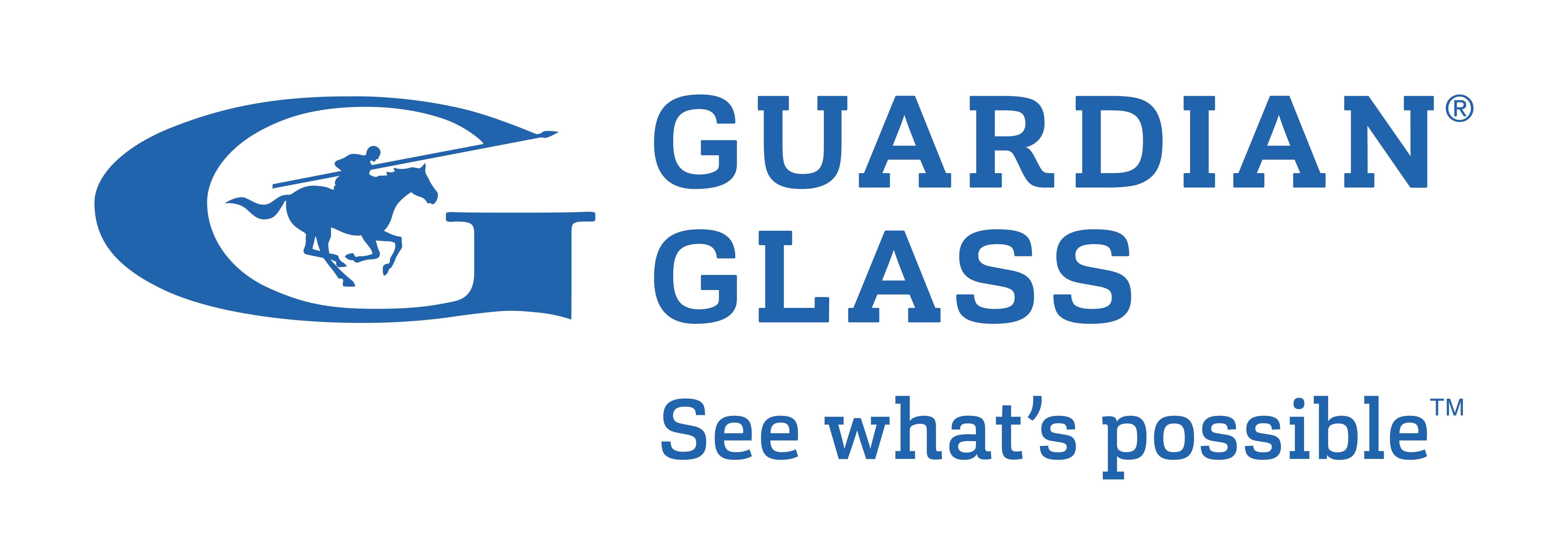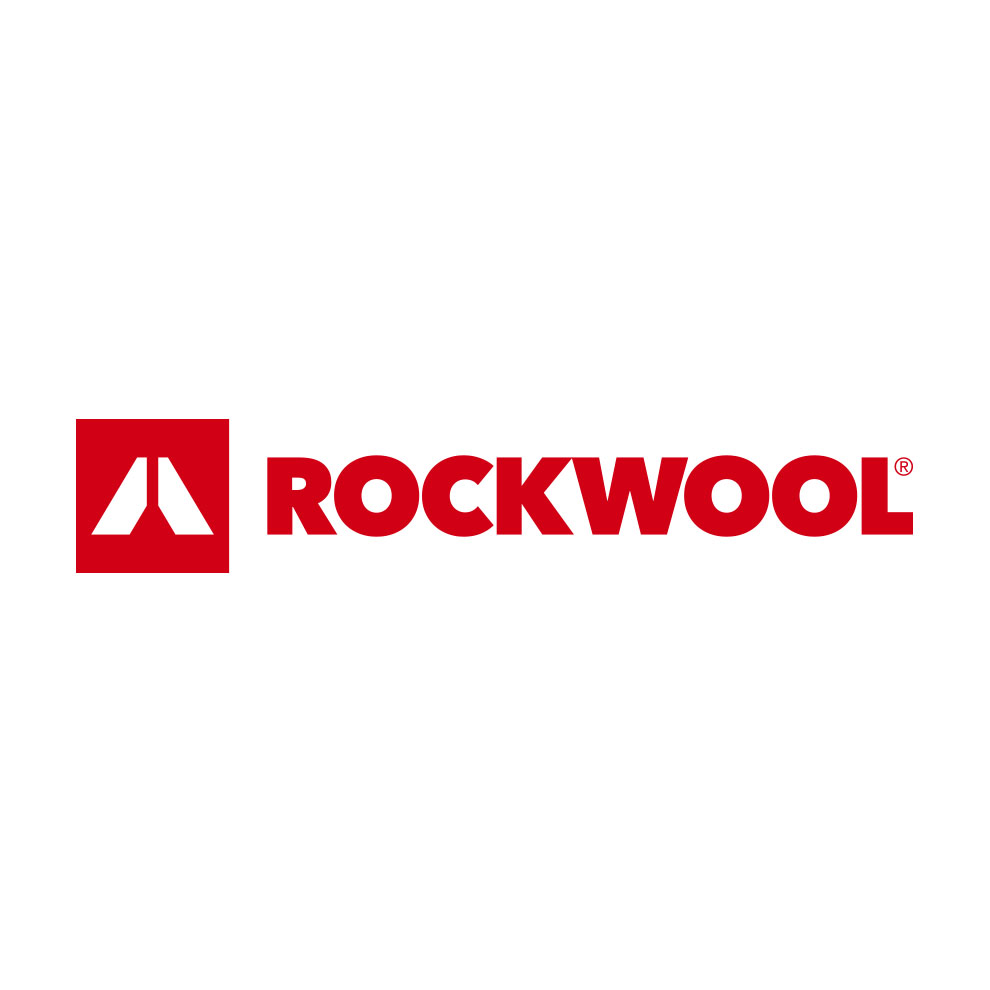This CE Center article is no longer eligible for receiving credits.
Over the years, the scale of sustainable design has exploded, creating an exhaustive list of considerations that range from the sustainability of the selected project site to the energy use and efficiency of the building, the health and wellness supported by the interior, and even the life-cycle impact and recycled content of every product included in the structure. In the past, navigating the necessary compromise was one of the biggest challenges inherent in satisfying sustainable criteria. For example, providing occupants with access to views also required protection from the glare and solar heat gain that causes discomfort and increases the load on the HVAC system, or choosing between products that would enable the building to perform with incredible efficiency or products that were produced with low environmental impact.
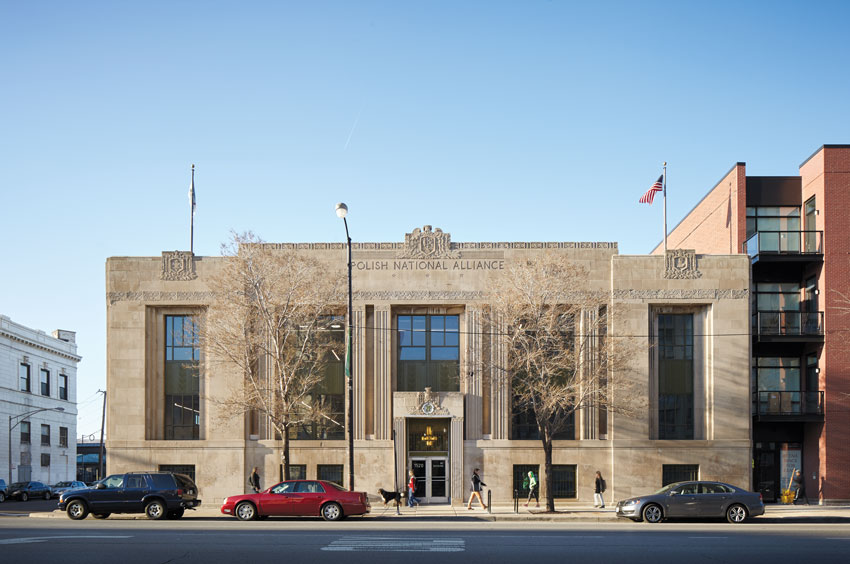
Photo courtesy of Mitsubishi Electric Cooling & Heating
Design firm Studio Gang transformed the National Polish Alliance building, built in 1937, into its Chicago office and earned the building the City of Chicago Landmark status, while creating a 21,000-square-foot office interior that was comfortable and energy efficient.
Today, the market is much better equipped to support the sustainable design effort. New products, research, and approaches to design enable projects to better satisfy the many different aspects of green building. This course will take a closer look at four projects that satisfied impressive sustainability objectives and the technology and product solutions behind their successful designs.
The HVAC Solution in the Historic Renovation of the Studio Gang Chicago Office
The Polish National Alliance building in Chicago, originally built in 1937, was recently transformed into the new Studio Gang Chicago office, the architecture and urban design practice founded and led by Jeanne Gang. The challenging renovation turned the existing structure into a 21,000-square-foot office space featuring a prairie roof and adjacent event space, and a City of Chicago Landmark building.
The project had several unique sustainability-related design goals. When the studio gang team began thinking about HVAC, that Landmark status became important and required that building performance significantly exceed current ASHRAE standards, while the physical disruption to the original structure was to be minimal. Aesthetically, maintaining the appearance of the historic building without visible modern-day enhancements was critical. The building also needed to function as a contemporary, high-performance office space, event space, and rooftop prairie. People in the building needed to feel comfortable and productive. The rooftop needed to be aesthetically pleasing and suitable for guests.
Careful consideration was given to the various building systems and technologies available to find solutions that would help the project achieve its many sustainability and performance-driven objectives. This was especially true in the case of selecting a suitable HVAC system. The design team needed to find a system that could help the building exceed the ASHRAE baseline performance by at least 17 percent, the mandatory performance criteria for attaining Landmark status. It was also important to keep employees and clients cozy in harsh Chicago weather without creating a historically inaccurate eyesore that would aesthetically disrupt the rooftop space.
For many reasons, designers knew that a conventional, big, packaged HVAC unit was not an appropriate solution. The Landmark Department was adamant about not being able to see the HVAC system components from the street, which made it difficult to add a big unit onto the rooftop of the 1937 structure. The HVAC system would need to be discrete and ultra-quiet so that people could enjoy the event space. Interior comfort was also an important consideration. “In our previous office, which was one open space, we had one massive HVAC unit with a single zone. In the summer, we would never get cool air over where I sat, while other people were too cold. Temperature striation was a big struggle,” explains Harry Soenksen, AIA, LEED AP, senior technical director at Studio Gang. “We also needed something with a small footprint that was acoustically reasonable for us, our neighbors, and attendees in the event space while being cost competitive.”
The HVAC Solution: VRF
The HVAC answer for the Studio Gang Chicago office project was a variable refrigerant flow (VRF) HVAC system. “VRF satisfied the functional, cost, acoustic, and visual requirements. In terms of cost, it was pretty competitive with a conventional system, but where VRF stood out was that it met Landmark’s performance requirements of exceeding ASHRAE standards by at least 17 percent. No other system could meet that requirement,” Soenksen explains.
The VRF Results: Comfort and Energy Savings
“We’ve been very happy,” said Studio Gang Chief Financial Officer Meredith Mack. “The VRF HVAC system has been far less noisy than the old system and way more consistent and comfortable than our old office. People are way more comfortable, and it’s actually costing us less per square foot,” Mack explains. The previous office space had a monthly expenditure (electric + gas) of $0.14 per square foot. The new office space comes in at $0.11 per square foot. In a 21,000-square-foot office space, that generates a savings of more than $600 every month.
Insulating The House at Cornell Tech to Achieve Passive House Certification
The House at Cornell Tech (The House) is a 26-story residential high-rise for students, staff, and faculty situated on Roosevelt Island in New York City designed by Handel Architects and Steven Winter Associates. Architecturally, this project is notable because when it was built, it was the world’s tallest building to earn certification from the rigorous Passive House international building standard. It has earned LEED Platinum status as well.
The Passive House building standard uses passive design principles to dramatically reduce the amount of energy necessary to heat and cool an interior to keep it comfortable. In short, the standard emphasizes the importance of proper insulation, proper windows, and the elimination of air leakages that enable hot air and heat energy to leave a building. More specifically, a passive building employs continuous insulation throughout its entire envelope to minimize thermal bridging. The building envelope is airtight, preventing infiltration of outside air and the loss of tempered air. Windows and doors are high performance, thermally broken, and triple glazed. There is often some form of balanced heat and moisture-recovery ventilation and a minimal space conditioning system. Buildings are oriented to maximize solar gain in the winter and minimize it in the summer. The impact of these passive measures on HVAC energy use is nothing short of astounding. Buildings built in compliance with the Passive House standard can reduce their demand for heating and cooling energy by up to 90 percent.

Photo courtesy of Handel Architects
The House at Cornell Tech earned certification from the rigorous Passive House building standard as well as LEED Platinum status.
High-quality insulation is critical to designing a successful passive construction project. Creating the well-insulated thermal envelope that helped The House to surpass the aggressive thermal performance criteria of the Passive House standard required semi-rigid stone wool insulation boards 280 millimeters (11 inches) thick in the exterior wall cavity. Lightweight, semi-rigid stone wool batt insulation was specified into the steel-stud interior wall and floor. Multipurpose stone wool boards were also incorporated into the walls, ceilings, and floors of the project. “The building envelope was constructed to exacting standards,” explains Debra Moelis, AIA, PHCD, senior associate, Handel Architects. “To achieve the necessary level of efficiency and thermal performance, new products, procedures, and innovative details were incorporated, including continuous insulation, overlapping vapor barriers, meticulous taping methods, and thermal separation of metals. Extensive, specialized training ensured that the installation and sealing were carried out with precision.”
Every structure that earns Passive House certification must pass a stringent on-site pressure test that ensures that these buildings are sealed airtight, with no leaky windows or building joints, making it possible for them to preserve indoor temperatures. Moelis notes that the building “heroically passed the notably difficult Passive House blower door test, with results that were four times better than required.”
The House became Passive House certified in the autumn of 2017, and it is estimated that this residential structure will save 882 tons of CO2 emissions per year, which is the equivalent of planting 5,300 new trees.
Lighting the Holocaust Memorial and Tolerance Center of Nassau County
The Holocaust Memorial and Tolerance Center of Nassau County in New York is tucked inside the Welwyn Preserve in Glen Cove. It was the first Holocaust museum and educational center to serve the nearly 3 million people on Long Island. In 2014, a $1-million renovation was completed, launching The Claire Friedlander Education Institute and dramatically improving the operation of the existing museum facility.
During the renovation, the lighting in the museum was replaced with architectural LED fixtures, including wall washers and monopoints. The lighting upgrade has resulted in several important benefits, including energy savings, simplified maintenance, and more flexible light placement. “With the new lighting, the lobby is now bright and inviting. It gives you a sense that you are in a space of deep history and knowledge,” explains Helen Turner, education director at the Holocaust Memorial and Tolerance Center of Nassau County.

Photo courtesy of WAC Lighting
During a renovation, the lighting in the Holocaust Memorial and Tolerance Center of Nassau County was replaced with architectural LED fixtures, including wall washers and monopoints.
“Before the renovation, we spent a lot of time and money replacing lightbulbs. With the new lighting, we are saving a lot of money, which is very nice,” Turner says. The architectural LED lighting selected for the Holocaust Memorial features proprietary drivers and LED modules that have been rigorously tested to perform longer than other products over their usable life. For example, both the monopoints and wall wash fixtures installed onto this project have a rated life of 50,000 hours, which means they could be left on for almost six years before the LED modules would need to be replaced.
The new lighting also improved the versatility of the museum space. “The new lights are very mobile. You can turn and angle them, put them up or down, and this flexibility can really change the feel of an exhibition,” Turner explains. The adjustability of the fixtures enable museum personnel to tailor the beam angle and directionality of the throw to precisely match the needs of each unique display.
“Beyond the beautiful and energy-efficient fixtures, we chose these lighting fixtures because of the ethics behind the lighting company,” Turner continues. “I think we have very similar missions to make the world a better place.”
The Glass Cladding on Anaha Tower Balances Beauty, Performance, and Sustainability
The Anaha Tower in Honolulu, Hawaii, is a luxury, 40-story, 311-unit residential building in the most distinguished urban neighborhood on O’ahu. Designed by Chicago-based architect Solomon Cordwell Buenz (SCB) in partnership with Hawaiian firm Benjamin Woo Architects, this LEED Silver-certified project features a high-performance, undulating curtain-wall facade. This distinct and beautiful blue-green glass cladding also manages solar energy with a superior level of precision, resulting in energy performance capable of attaining impressive sustainable design certifications.
“The Hawaiian name Anaha translates to mean the reflection of light,” explains Strachan Forgan, principal at SCB. “Abstractions of waves are common in the island’s artistic traditions. The tower’s shape is derived from a sequence of softly curved floor plates, wrapped in a smooth glass skin. The composition is reminiscent of the play between the crests and troughs of a calm ocean wave. Like a wave, the reflection of light off the facade will constantly alter as the viewpoint and environmental conditions change.”

© Marco Garcia
The high-performance glass cladding selected for the Anaha Tower in Hawaii could be radiused in large pieces, without optical distortion, and met important solar performance metrics in terms of glare control and solar heat gain management.
The Anaha Tower is clad in 275,000 square feet of glass, 20,000 square feet of which is curved glass, also referred to as bent glass. “In order for the design concept to be successfully executed, it was important that the alternating glass forms be read as soft and interlocking,” Forgan continues. “This was achieved by using true radiused insulated units and not faceting the windows at the corners. Selecting a high-performance coated glass that could be radiused in large pieces, without optical distortion, was a key technical decision in support of the design.”
The functional performance of the glassc facade had to balance the ability to maximize the amount of beautiful Hawaiian light allowed into the residences, while preventing glare and solar heat gain from causing discomfort and spiking energy bills. Ultimately, the glass specified into the curtain wall provided enhanced solar control that allowed residents to comfortably enjoy their stunning views with minimal deployment of shades.
“The glass we selected for the Anaha Tower project featured the only coating on the market that could be bent and meet the solar management performance criteria, in terms of solar heat gain control and visible light transmission, required by the energy requirements,” Forgan says.
These four projects showcase that sustainability no longer requires compromise when the right solutions are selected. Keep reading for more information on the systems that helped the designers of the featured projects achieve their multifaceted goals.
The HVAC System that Delivers Comfort and Energy Savings with Minimal Footprint
The VRF HVAC system used in the Studio Gang Chicago office building delivered comfort and energy savings within a small enough footprint to enable the historical building to achieve Landmark status. When looking to specify a system that can provide this combination of benefits, seek a VRF HVAC solution that incorporates an inverter-driven compressor technology, is capable of heat recovery, and uses a two-pipe configuration that can simultaneously cool and heat different areas within a building. Here is a little more information about a VRF system and how it differs from the traditional HVAC solution.

Photo courtesy of Mitsubishi Electric Cooling & Heating
VRF HVAC solutions require smaller runs of ductwork to distribute the conditioned air, dramatically reducing the necessary footprint of the system.
Introducing the VRF System
Traditional commercial HVAC systems inefficiently move conditioned air or water throughout a building. Not only does it require a lot of energy to move that air or water, but those mediums are challenged to provide precise temperature control. A variable refrigerant flow (VRF) system moves conditioned refrigerant directly to the zone to be cooled or heated, conditioning the air within the space and delivering precise and efficient comfort control. Many systems also provide the ability to simultaneously cool some zones while heating others or to limit conditioning to only zones that are in use.
“Traditional cooling and heating systems require tremendous energy to force air from a central blower to a room through a complex system of ductwork, which uses space in buildings and wastes energy. With VRF systems, installation time and costs are reduced, building occupants are comfortable, and energy bills are lower,” explains Kevin Miskewicz, director of commercial marketing, Mitsubishi Electric Trane HVAC US.
Inverter-Driven Compressor
In HVAC terminology, the compressor is the engine driving the HVAC system. In traditional HVAC systems, the compressor speed is constant. It can be on or off. In a VRF system, an inverter-driven compressor controls the speed of the system and can vary the speed depending upon the HVAC needs of the building. The variability of the compressor motor speed can create incredible energy savings.
Heat Recovery
An HVAC system that is capable of heat recovery takes the heat extracted from zones that require cooling and uses it in zones that require heat. This repurposing of available heat allows for better thermal performance across different zones and contributes toward the impressive energy efficiencies created across these systems. It is important to note that VRF systems capable of heat recovery can simultaneously cool and heat different zones within a building.
Small and Simple Refrigerant Piping
VRF HVAC systems distribute refrigerant to the area of the building that needs it, conditioning air locally, rather than conditioning air in a central area and then distributing the conditioned air throughout the building. This essentially flips the structure of the system as well. Instead of pulling one run of refrigerant piping from the outside unit to a central location and having bulky ductwork traipse throughout the building to deliver conditioned air, VRF HVAC systems feature more runs of the smaller refrigerant piping pulled to different areas of the building and shorter runs of smaller, low-profile ductwork to deliver the conditioned air into the immediate space, making the footprint of these systems much smaller and easier to design around.

Photo courtesy of Mitsubishi Electric Cooling & Heating
The use of a VRF HVAC system in the Studio Gang Chicago office created a comfortable interior that reduced energy use by more than $600 per month.
Two-Pipe System Format
A VRF system is available as either a two-pipe or three-pipe system. The two-pipe solution dramatically reduces the total amount of refrigerant piping needed for the project, making design and installation easier and less expensive. In terms of functionality, there are two-pipe systems that can simultaneously heat and cool interior areas. A two-pipe system capable of heating and cooling simultaneously was selected for the Studio Gang Chicago office space.
Adoption of VRF Systems Worldwide
The technology is gaining popularity in the United States due to its ability to deliver an incredible combination of benefits, enabling designers to achieve aggressive energy performance and interior comfort goals. The system’s small footprint makes it easier to incorporate into new construction as well as existing buildings.
The Stone Wool Insulation Creating High-Performance Envelopes
Insulation is an important component of a high-performance, sustainable building. In creating the envelope of the Passive House-certified project The House at Cornell Tech, designers created continuous insulation free from the thermal bridges that compromise thermal performance, essentially wrapping the building in an insulated blanket. In order to accomplish this, designers used stone wool insulation in various products and forms.

Photo courtesy of Handel Architects
Various forms of stone wool insulation were used inside the building envelope of The House at Cornell Tech to surpass the aggressive thermal performance criteria of the Passive House standard.
Introducing Stone Wool Insulation
Stone wool insulation is made of melted stone and recycled materials that are spun into a wool. Stone wool insulation brings the natural strengths of stone into the envelope and interior of a building. This sustainable material is inherently fire resistant, mold and mildew resistant, and absorbs sound, supporting the design of safe and sustainable buildings in many different ways.
Available for Exterior and Interior Application
There are several stone wool insulation products that have been developed to meet the specific needs of various exterior wall systems, such as rainscreen, cavity wall, exterior continuous insulation, curtain wall, and wood-frame and metal-frame constructions. These stone wool solutions are fully compatible with a very diverse array of building components and claddings, enabling designers to create beautiful and creative high-performance building envelopes. Stone wool insulation products are also available for internal and separation wall applications.
Create Continuous Insulation
Continuous insulation is defined by ASHRAE 90.1 as “insulation that is continuous across all structural members without thermal bridges other than fasteners and service openings. It is installed on the interior, exterior, or is integral to any opaque surface of the building.” When built correctly, continuous insulation creates a super-insulated building envelope that can also help to achieve NFPA 285 compliance and aggressive performance and sustainability targets. The variety of stone wool insulation products ensures that designers have the tools to create continuous insulation in numerous applications.
Additional Benefits
Stone wool insulation products can provide many significant benefits to the building, the occupants, and the environment, truly embodying the spirit of sustainable design. Regardless of project or application, there are high-quality stone wool insulation solutions that enhance building performance by improving energy efficiency and occupant comfort, while providing moisture management, vapor permanence, fire safety, and acoustical control that contribute toward satisfying green building criteria.
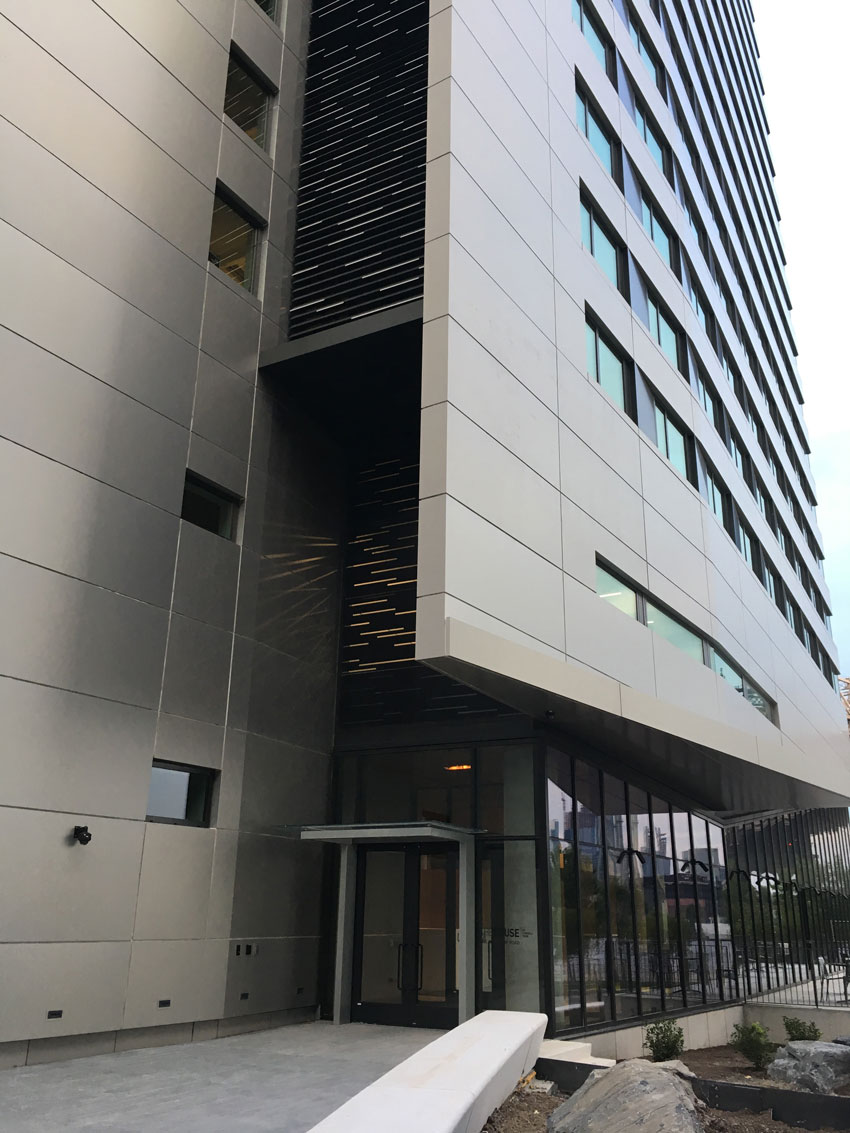
High-quality stone wool insulation solutions also improve the ability of the building envelope to provide moisture management, vapor permanence, fire safety, and acoustical control.
Fire Resilience
Stone wool insulation is a key component within NFPA 285-compliant wall assemblies. The material is noncombustible, resisting fire up to 2,150 degrees Celsius (3,902 degrees Fahrenheit), and will not develop toxic smoke or promote flame spread, even when directly exposed to fire, as some other insulation materials do. This means that designers effectively create fire barriers wherever the stone wool insulation is used on the exterior or interior of a building.
Acoustic Capabilities
The density and non-directional fiber structure of stone wool products give it excellent acoustic properties. When used in exterior wall systems, the insulation can prevent the sounds of traffic and trains or other construction projects from disturbing the peace of the interior environment. In addition, incorporating stone wool insulation into internal and separating walls reduces airflow, thereby decreasing sound transmission across the wall system.
Water Properties
Stone wool insulation is hydrophobic, which means it repels water. This vapor-permeable solution offers unparalleled moisture management and excellent drying potential. If the product comes into contact with water, it will dry out quickly and maintain its original R-value. Stone wool products resist the growth of mold and mildew and are GREENGUARD-certified low emission, contributing toward better indoor air quality.
Circularity
Stone wool insulation products are produced with igneous rock, a sustainable raw material, and recycled byproducts from other industries. Stone wool can also be recycled into new stone wool products creating a circular life cycle for stone wool insulation.
Energy Efficiency and Design Freedom
“Energy efficiency is playing an ever-increasing role in the design and construction of buildings,” says Kim Friedrich, marketing manager for ROCKWOOL. “Yet design freedom is the quintessential factor that makes architecture truly inspiring. While the challenges are rising, it’s possible to rise to the challenge by equipping buildings with high-performance envelopes. The impact of passive measures, like insulation, on the performance of a building envelope cannot be overstated. By pairing noncombustible stone wool insulation with cladding that brings the vision to life, designers provide the crucial passive fire protection and energy efficiency their clients and building codes demand, without limiting their creativity. Now, design freedom goes hand-in-hand with energy efficiency, fire safety, durability, resiliency, and constructability. Stone wool insulation delivers sustainable design without compromise.”
Sustainable Lighting: Energy Efficient, Long Life, Zero Landfill, and Comfortable
It is a well-known fact that LED lighting is often much more energy efficient than comparable fluorescent, halogen, or metal halide light sources. It may be surprising to learn that if every traditional bulb in the United States was switched to an LED light source right now, the country would need 44 fewer power plants, and it would create an energy savings equivalent to $30 billion dollars. That is a sizable reduction in the energy footprint of the United States with just the swap of a light source.
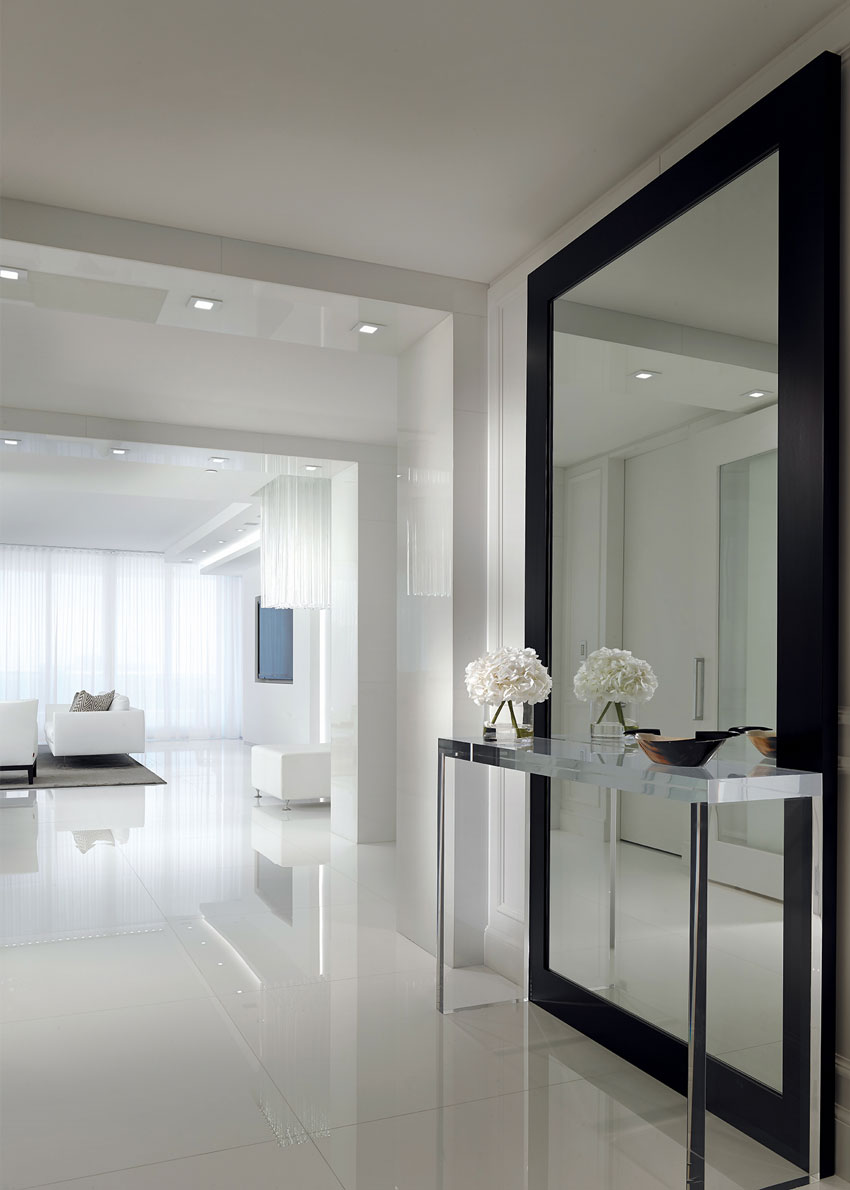
Photo courtesy of WAC Lighting
LED lighting can be manufactured in a zero-landfill facility, dramatically reducing the product’s environmental footprint that exists before it is installed into a space.
The conversation about sustainability, however, is broader than just energy savings. “The idea of sustainability is multifaceted,” explains WAC Lighting President Shelley Wald. “Energy efficiency is a part of the story, but it’s just a part. The impact of manufacturing, the life cycle of the product, and the functionality of the product all play a role. For a lighting solution, an LED fixture that operates 80–90 percent more efficiently than traditional lamps and lasts 25 times longer can also be manufactured in a zero-landfill facility and create a comfortable light environment that supports the various visual tasks that will be performed there. That, in totality, is a sustainable solution.”
Zero-Landfill Manufacturing
One of the largest polluters in the United States is the manufacturing process itself. The goal of Zero Landfill programs is to divert all solid waste from landfills, managing the impact that a product may make on the environment before it is purchased and used. There are verifiable tiers to the Zero Waste effort. Facilities that achieve a landfill waste diversion rate of 100 percent earn a Zero Waste to Landfill recognition. Facilities that earn a Virtually Zero Waste to Landfill certification achieve a landfill diversion rate of 98 percent or greater, and a Landfill Waste Diversion designation is earned by manufacturers that have achieved a landfill waste diversion rate of 80 percent or greater. There are lighting manufacturers who have achieved the Zero Waste to Landfill designation, and every decision impacts their ability to achieve this certification while making a more desirable and cost-effective solution. Here are a few examples.
Sustainable Decision: Use Aluminum Material
Aluminum is a very recyclable material and a fantastic heat sink for LED lighting fixtures. Using aluminum for a heat sink is a great example of a truly sustainable solution because it is one of the best thermally conductive materials, which makes it an ideal heat sink on these highly efficient lighting fixtures, and it can be melted down and reformed into another product perpetually, never entering a landfill.
Sustainable Decision: Powder Coating over Wet Spray Paint
The decision to finish a product with a powder coating or a wet spray paint also contributes toward the overall environmental impact of the manufacturing process. Powder coating is an environmentally friendly process that creates a more durable finish, without creating waste or sending chemicals into the water stream. The powder is applied to the product surface and then baked. Any powder that falls off during the application process is reused during the next application. Alternatively, the imprecision of the wet paint spray process creates waste with every application, and the paint that doesn’t hit the product can be sent into the local water supply when the area is cleaned.
Comfort and High-Efficacy Performance
Another important aspect of sustainability, especially when talking about the sustainability of a lighting solution, is the comfort of the visual environment it produces. If a product is highly efficient but creates an environment that is uncomfortable and difficult for people to work in, then it misses on a key criteria of sustainability.
Designing LED lighting products to be both highly efficient and successful in creating a comfortable visual space is a challenge in the industry today. In fact, the U.S. Department of Energy (DOE) recently completed a study evaluating the performance of several LED lighting products that claimed efficacies near or exceeding 200 lumens per Watt (lm/W). While the study validated that the fixtures performed as described by the manufacturer, in terms of efficacy, power draw, color temperature, and color rendering index (CRI) values, it revealed that five out of the seven fixtures received very low ratings for visual comfort and overall quality, with many observers complaining about the glare produced by the luminaires. The product that received the highest overall rating also had the lowest tested efficacy (136 lm/W), demonstrating that there is more to consider when selecting a sustainable fixture than efficacy alone.
Putting It All Together: The Solar Decathlon
The U.S. Department of Energy Solar Decathlon is an award-winning program that challenges collegiate teams to design, build, and operate solar-powered houses that are cost-effective, energy-efficient, and attractive. The competition was started in 2002 and takes place every two to three years.
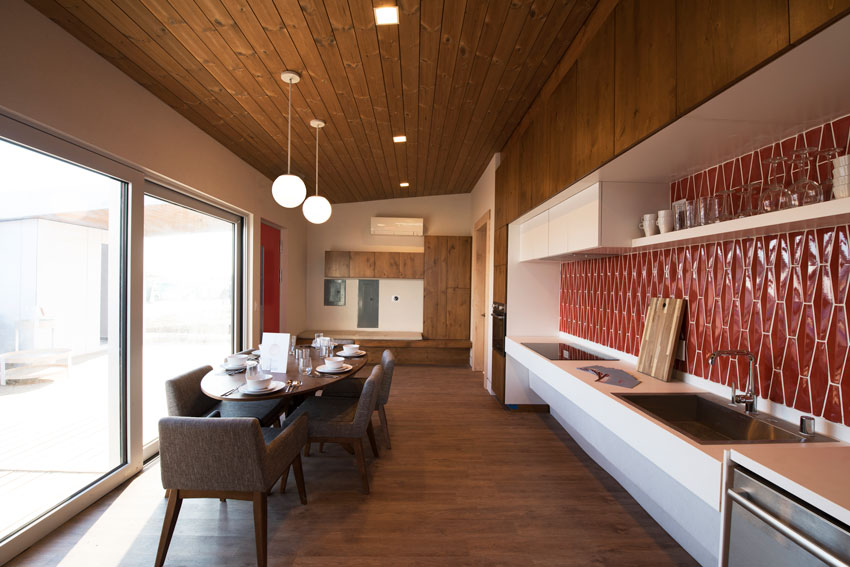
Photo courtesy of WAC Lighting
“We wanted to use LED lighting fixtures because they are the most efficient, but the quality of light also creates that home feel,” explains Alla Elmahad from the University of Maryland, participant in the 2017 Solar Decathlon held in Denver.
During the 2017 competition held in Denver, teams designed zero-net-energy homes and competed in 10 contests that compared the design and performance of each project in terms of water use and reuse strategies, smart energy use, market potential, energy-efficient heating and cooling systems, occupant health and comfort, and innovation. The range of contests showcases the multifaceted nature of sustainable design: it must be energy efficient but also comfortable and beautiful.
Students remarked on the beauty and efficiency of the selected LED lighting fixtures. “We wanted to use LED lighting fixtures because they are the most efficient,” explains Alla Elmahad from the University of Maryland. “But the quality of light creates that home feel, and these fixtures create a really beautiful aesthetic that isn’t sharp but calm, which really makes it feel like a home.”
The Sustainability Benefits of Glass
Architects often consider glazing to be a major source of thermal gains and losses, which increases building energy consumption. However, with the right glazing products, building orientation, window-to-wall ratio, and shading elements, the glass facade can effectively control environmental factors such as heat, light, and sound. The result can be a beautiful, sustainable building that offers impressive energy management.
Performance Metrics: The Function of Glass
There are performance metrics that will describe how the glass manages the solar radiation to which it is exposed. It is important to note that solar radiation is comprised of different types of energies, including visible light and infrared and ultraviolet radiation. Direct exposure to solar energy will cause the interior of a building to increase dramatically in temperature, requiring large amounts of cooling to ensure a comfortable environment. The way that glass manages the available visible light and radiation directly impacts the comfort and energy performance of the building, which contributes toward the overall sustainability of the building. A building with direct sun exposure should be fitted with low solar-heat-gain, low-E-coated glass to help suppress cooling load requirements.
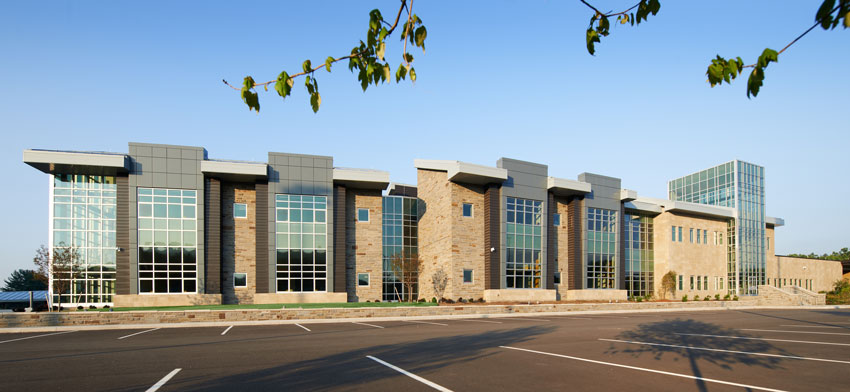
© Guy Cali Associates
The coated glass used in the Owego Elementary School in New York offers maximum heat flow resistance, while still allowing abundant natural light to pass into the building.
The performance metrics that help designers to select glass that will perform as necessary are the visible light transmittance, solar heat gain coefficient, and U-value of the glass.
Visible Light Transmittance (VLT)
Visible light transmittance (VLT) is the percentage (%Tvis) of visible light within the solar spectrum that is transmitted through glass.
Visible Light Reflectance
Visible light reflectance is the percentage of visible light within the solar spectrum that is reflected from the glass surface.
Solar Heat Gain Coefficient (SHGC)
The solar heat gain coefficient is the percent of solar energy incident on the glass that is transferred indoors both directly and indirectly through the glass and is quantified as a number between 0 and 1.
U-Value
A measure of the heat gain or loss through glass due to the difference between indoor and outdoor air temperatures. Some combinations of high-performing, low-E glass can bring U-value performance of double-glaze units close to that of triple glaze, providing maximum heat flow resistance while still allowing abundant natural light.
Balance Light and Heat Trespass with Spectrally Sensitive Glass
Spectrally selective glass is high-performance glazing that admits as much daylight as possible while preventing the transmission of as much solar heat as possible. By controlling solar heat gains in the summer, preventing the loss of interior heat in the winter, and allowing occupants to reduce electric lighting use by making maximum use of daylight, spectrally selective glazing significantly reduces building energy consumption. The United States Department of Energy has established a light to solar gain (LSG) ratio of 1.25 as the minimum measurement to be classified as spectrally selective glazing.
Contribution of Glass to LEED v3 and LEED v4
There are two versions of the LEED program currently in effect: LEED 2009 (v3) and the new LEED v4. All new projects must be designed using the LEED v4 rating system, but design professionals who registered projects with LEED v3, even projects not yet started, may continue to provide submittals for certification until June 6, 2021, when the rating system officially closes.

© Dean Riggott Photography
The glass selected for the Mayo Civic Center expansion provides high visible light transmission, while its low solar heat gain coefficient controls unwanted heat to help buildings efficiently manage HVAC performance.
Some types of architectural glass can help contribute up to 20 total points in four of the six LEED categories in both LEED v3 and LEED v4 green building programs. For example, in the Sustainable Sites category, architectural glass tested by the American Bird Conservancy can satisfy the requirements for the Bird Collison Deterrence credit. Glass with an SR value of 0.33 or above reflects solar energy and can be used to reduce the heat island effect, contributing toward the Heat Island Reduction credit. Glass products with an environmental product declaration (EPD) and a health product declaration (HPD) are now available, providing transparency and contributing toward several credits in the Materials and Resources (MR) category, including the Building Product Disclosure and Optimization credits.
“Architectural glass products can help architects realize their most inspired visions while also delivering the sustainability performance that’s essential in today’s new construction and retrofit projects,” explains Darijo Babic, architectural sales director, Guardian Glass.
In summary, there are now glass, HVAC, insulation, and lighting solutions that help designers to satisfy multiple sustainable design criteria simultaneously. Glass can provide views and protect the interior from glare and solar heat gain. HVAC systems can update existing structures to provide modern-day performance, without impacting their historic appearance. Insulation products can wrap a building in a continuous thermal blanket and offer fire resilience and resistance to mold and mildew. Highly efficient LED luminaires can still create a comfortable, inviting interior and be manufactured in a very eco-conscious way. The options available for sustainable design have evolved beyond forcing designers to compromise—now they can have it all.













